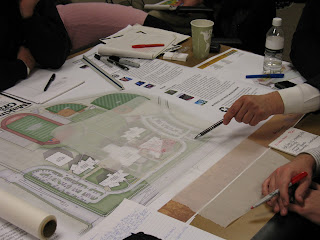 By: April Brown
By: April BrownThrough a recent federal government grant with the General Services Administration (GSA), the Institute for the Built Environment summarized the current state of research on effective strategies to reduce the carbon footprint, resource use, and costs of operating existing buildings. By utilizing research from academia, national laboratories, and professional associations, we have identified key low-cost opportunities in 5 high impact areas for energy conservation: plug and process load management, water efficiency, daylighting, behavior engagement, and operational efficiency. Our findings elevate the conversation in facilities management by clarifying the role of energy efficiency, occupant behavior, building maintenance staff and organizational leadership, and sustainability. Additionally, our findings prioritize high impact energy saving tips and best management practices based on return on investment data for operational sustainability in buildings. April Brown, co-author of the research for GSA, answers 4 frequently asked questions related to energy efficiency and facilities management of existing buildings based on recent studies.
1. What if I want to improve the energy use at my office, but don’t have a lot of money or don’t have control of the major mechanical systems or building envelope. Can I make meaningful changes on a limited budget?
Yes, actually, there several operations and maintenance activities that have significant energy savings with little upfront cost and require little control over building systems. In fact, low cost operations and maintenance measures realize the same energy savings as equipment retrofits and cost 20 times less. The first place to start is with implementation of a few simple and straightforward building operations and maintenance best practices. It may sound unlikely that such savings can be achieved through these simple changes, but studies have shown that developing and implementing best practices has significant impact. For example, after 4 years of operating with definitive best practices, a Spain university reduced energy costs by $676,750, annually, which had a 2.5 year return on investment. Key best practices in saving operational energy costs include the following:
- Planning and goal setting – Develop energy management plan with energy efficiency as a key strategic goal of the organization and incorporate goals for energy efficiency into the business plan. Encourage proactive actions and keep senior management regularly informed and engaged in the progress toward achieving goals.
- Appoint an energy manager –Designate an individual responsible for managing energy and promoting energy-efficient building operation. Often the cost savings generated by an experienced energy manager can easily cover his or her salary. Usually buildings/portfolios over 300,000 square feet would require a certified energy manager; otherwise assigning energy management tasks to a qualified staff person may be sufficient.
- Perform operations and maintenance assessments – Operations and maintenance assessments seek to understand why the building is operated and maintained in a certain way. To be clear, an O&M assessment is not an energy audit, rather, the assessment evaluates the current O&M program and practices, including the management structures, policies, and user requirements that influence them. Assessments are critical to understanding where opportunities exist and what documentation is lacking. For more information on O&M assessments see Operation and Maintenance Assessments for Energy Efficient Building Operation.
- Whole building energy accounting – Track and analyze past and current energy use, demand (electricity), and cost using a convenient and reliable methodology (e.g. ENERGY STAR Portfolio Manager). Be sure to share energy accounting information with facilities staff as they are often the most involved with operating and maintaining the building, yet they know the least information on energy use. Distribute report to both senior management and facilities staff and show how you are meeting the organization’s strategic goals for energy reduction.
- Documentation – Buildings systems and operating plans are invaluable to properly maintaining your building. With operating documentation, such as written sequences of operation or control strategies, provide a reference to check against when changes occur and ensure that changes in sequencing are continually documented. These resources eliminate energy waste by providing confidence in whether the operations schedules are intended or off track. Videos and photographs can complement written documentation.
- Appropriate equipment scheduling – Equipment
schedules should meet occupant needs but not exceed. The easiest way to waste
energy is to leave equipment and lights on when they could be off. Equipment schedules
are often adjusted to meet the need of a special program but not reverted back
to normal operations. Therefore, continual review of scheduling eliminates
waste. The payback for improved scheduling is almost immediate because of the
little cost, including labor.
Office equipment can make up as much as 30% of electricity consumption in an office, making this a great target for reducing wasted energy and paying closer attention to office schedules and occupancy needs. Key best practices are:
- Procurement – Purchase ENERGY STAR equipment when it’s time to replace office equipment. Once study found that ENERGY STAR equipment resulted in 18% energy savings. When purchasing computers, prioritize laptops over the desktop computers as laptops typically use a third of the energy of desktop computers. If you still have CRT monitors, it is high time to replace those with LCD monitors, which use less than half of the power draw of CRT monitors. Additionally, adjust brightness to the dimmest setting that the ambient lighting in the room will allow or consider automatic brightness controls, which change the brightness based on the ambient light levels. Institutionalize the use of centralized printers where several workstations use one printer. Also, consider inkjet printers when possible as they use significantly less energy than other printers.
- Power management settings – Enable aggressive power management settings before distributing equipment to staff. Low power modes include setting computers and laptops to sleep mode after 15-60 minutes of inactivity – the shorter the better. Also, educate staff on how to activate even lower power modes and why it’s important.
- Shutoff interventions – Other plug load reduction strategies seek to shutoff plugs through load or occupant sensor plug strips (27% energy savings), schedule-based controls (40+% energy savings), and email reminders (6% energy savings). In one GSA study, schedule based plug strips were installed after enabling low power settings and reduced plug loads at workstations by an additional 26%. Payback must be evaluated as the cost of these advanced power strips can be prohibitive.
Well, while both are well intended, research shows that dual flush toilets and automated faucets use more water than expected from the flush and flow rate specifications. Depending on what type of fixture they are replacing, they can actually increase indoor water use. Dual flush toilets typically use more water than projected because the flush mechanism is not aligned with user behavior, meaning the dual flush handle is designed to pull up for a low-flow flush and down for a full flush. As we toilet users are already conditioned to push the handle down, our primary behavior decreases the efficiency of the toilets. The appropriate use of the handle can be increased through the education of building occupants; however some building owners have elected to reverse the handle design to align with user behavior. Also, the type of building occupant must be considered; for example, if the building primarily serves visitors then education is not effective. Furthermore, dual flush fixtures never make sense in bathrooms where urinals are present, as the toilet is typically used only for the full flush in this instance. There is a great resource available, called Maximum Performance (MaP), that shows the performance specifications of many toilets available on the market, comparing performance of waste removal (grams per flush) and flow rate. For example, many toilets flush 1,000 grams per flush with 1.28 gallons of water per flush (20% water savings compared to code). In summary, single low-flush toilets are the best at sufficiently eliminating solid waste and guaranteeing water savings.
4. What are some in-house activities that we might be able to do to reduce energy consumption without needing outside contractors?
For larger, more complex buildings and/or portfolios, there are two primary operations and maintenance strategies that encompass many of the known and documented best management practices – building re-tuning and energy information systems.
Re-tuning is a comprehensive set of activities that evaluate a buildings’ energy management and control systems to ensure that schedules and controls are appropriate and operating correctly. Re-tuning seeks to identify and correct building operational problems that lead to energy waste, ensuring maximum energy efficiency and occupant comfort year after year. Essentially, re-tuning is a scaled-down version of retro-commissioning. A key difference between re-tuning and retro-commissioning is that, once properly trained, re-tuning can be done with in-house staff, whereas retro-commissioning typically requires an outside contractor. Furthermore, because re-tuning is done in-house, building operators and owners take ownership of the faults and corrective actions, ensuring persistence with energy savings. Re-tuning and Energy Information Systems are complimentary to each other, as re-tuning relies on energy analysis to evaluate the economic impact of corrective actions.
Energy Information Systems (EIS) are advanced energy tracking software, hardware, and communication technologies used to store, analyze, and publish building energy information. EIS are not energy management and control systems (EMCS) or building automation systems (BAS), as these systems control the energy consuming systems in a building. Instead, EIS connect with the buildings’ EMCS or BAS to gather and track the energy data, then analyze the data against weather files, baselines and benchmarks and send alerts to managers. Additionally, EIS are not information dashboards, batch analysis tools, greenhouse gas footprint calculators, or environmental monitors. EIS pertain more specifically to efficient building operations by offering a proactive approach to energy management using meters and sophisticated software to read, analyze, and alert based on readings. In essence, EIS supports real-time detection of energy waste, allowing staff to identify the cause and determine the appropriate response. EIS are a promising solution for building managers to continuously reduce energy use and costs. EIS may be too sophisticated for some building owners but the concept is scalable. Small building owners can start small with whole building benchmarking and energy accounting. Studies show that simple benchmarking and tracking still result in energy savings, concluding that just by monitoring we notice simple opportunities for improvement. EPA analyzed the ENERGY STAR portfolio manager buildings and found that during the years 2008-2011 buildings had an average annual savings of 2.4%. The more sophisticated the accounting and tracking program, the more energy savings potential. One study found that permanent metering and continuous monitoring saved 9% in energy use. Other studies show that buildings with sophisticated EIS save up to 25% energy costs.
Re-tuning and EIS focus on the operational efficiency of building operations. Often operations and maintenance best management practices focus on improving maintenance procedures and equipment efficiency, however, facilities staff should equally consider how their building is wasting energy because no matter how efficiently your equipment is running, if it’s running when it doesn’t need to be you are wasting precious money and resources.





















